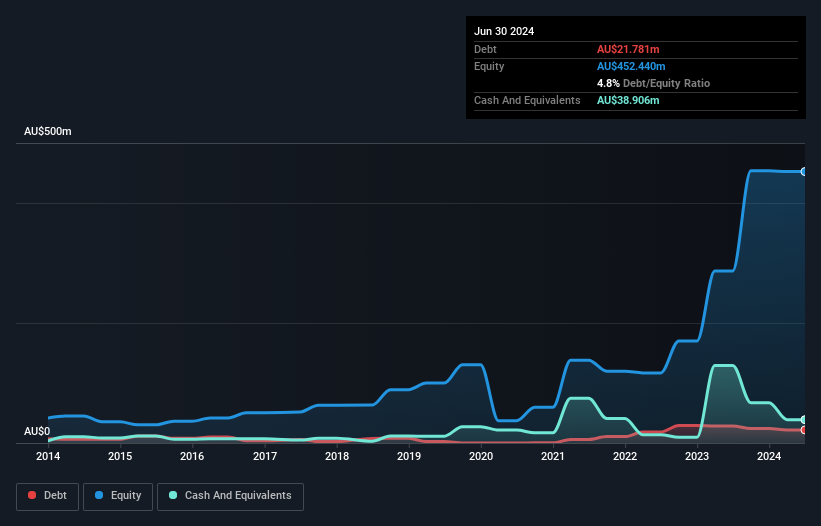Legendary fund manager Li Lu (who Charlie Munger backed) once said, 'The biggest investment risk is not the volatility of prices, but whether you will suffer a permanent loss of capital.' When we think about how risky a company is, we always like to look at its use of debt, since debt overload can lead to ruin. Importantly, Strike Energy Limited (ASX:STX) does carry debt. But the real question is whether this debt is making the company risky.
Why Does Debt Bring Risk?
Debt assists a business until the business has trouble paying it off, either with new capital or with free cash flow. Ultimately, if the company can't fulfill its legal obligations to repay debt, shareholders could walk away with nothing. While that is not too common, we often do see indebted companies permanently diluting shareholders because lenders force them to raise capital at a distressed price. By replacing dilution, though, debt can be an extremely good tool for businesses that need capital to invest in growth at high rates of return. The first step when considering a company's debt levels is to consider its cash and debt together.
Check out our latest analysis for Strike Energy
What Is Strike Energy's Net Debt?
You can click the graphic below for the historical numbers, but it shows that Strike Energy had AU$21.8m of debt in June 2024, down from AU$28.3m, one year before. But on the other hand it also has AU$38.9m in cash, leading to a AU$17.1m net cash position.

How Strong Is Strike Energy's Balance Sheet?
According to the last reported balance sheet, Strike Energy had liabilities of AU$45.1m due within 12 months, and liabilities of AU$29.6m due beyond 12 months. Offsetting this, it had AU$38.9m in cash and AU$12.1m in receivables that were due within 12 months. So its liabilities outweigh the sum of its cash and (near-term) receivables by AU$23.7m.
Given Strike Energy has a market capitalization of AU$630.4m, it's hard to believe these liabilities pose much threat. But there are sufficient liabilities that we would certainly recommend shareholders continue to monitor the balance sheet, going forward. While it does have liabilities worth noting, Strike Energy also has more cash than debt, so we're pretty confident it can manage its debt safely.
We also note that Strike Energy improved its EBIT from a last year's loss to a positive AU$2.5m. The balance sheet is clearly the area to focus on when you are analysing debt. But ultimately the future profitability of the business will decide if Strike Energy can strengthen its balance sheet over time. So if you want to see what the professionals think, you might find this free report on analyst profit forecasts to be interesting.
Finally, a company can only pay off debt with cold hard cash, not accounting profits. Strike Energy may have net cash on the balance sheet, but it is still interesting to look at how well the business converts its earnings before interest and tax (EBIT) to free cash flow, because that will influence both its need for, and its capacity to manage debt. Over the last year, Strike Energy saw substantial negative free cash flow, in total. While investors are no doubt expecting a reversal of that situation in due course, it clearly does mean its use of debt is more risky.
Summing Up
While it is always sensible to look at a company's total liabilities, it is very reassuring that Strike Energy has AU$17.1m in net cash. So although we see some areas for improvement, we're not too worried about Strike Energy's balance sheet. The balance sheet is clearly the area to focus on when you are analysing debt. However, not all investment risk resides within the balance sheet - far from it. These risks can be hard to spot. Every company has them, and we've spotted 2 warning signs for Strike Energy (of which 1 is concerning!) you should know about.
At the end of the day, it's often better to focus on companies that are free from net debt. You can access our special list of such companies (all with a track record of profit growth). It's free.
New: Manage All Your Stock Portfolios in One Place
We've created the ultimate portfolio companion for stock investors, and it's free.
• Connect an unlimited number of Portfolios and see your total in one currency
• Be alerted to new Warning Signs or Risks via email or mobile
• Track the Fair Value of your stocks
Have feedback on this article? Concerned about the content? Get in touch with us directly. Alternatively, email editorial-team (at) simplywallst.com.
This article by Simply Wall St is general in nature. We provide commentary based on historical data and analyst forecasts only using an unbiased methodology and our articles are not intended to be financial advice. It does not constitute a recommendation to buy or sell any stock, and does not take account of your objectives, or your financial situation. We aim to bring you long-term focused analysis driven by fundamental data. Note that our analysis may not factor in the latest price-sensitive company announcements or qualitative material. Simply Wall St has no position in any stocks mentioned.
About ASX:STX
Strike Energy
An independent gas producer, explores for and develops oil and gas resources in Australia.
Undervalued with adequate balance sheet.
Similar Companies
Market Insights
Community Narratives




